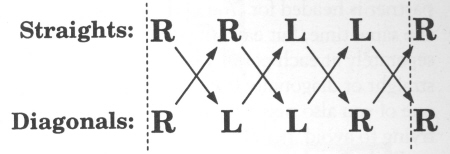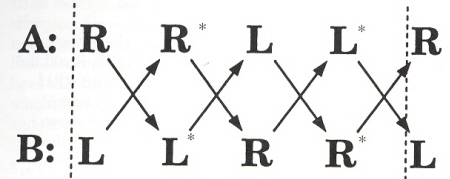|
After
you've gotten twelve throws working, try building up the second half
of the pattern by itself, just like you did the first. To start with
the second half, everyone will have to start left handed and the
feeder will do LRL, RRL. See the second half of the causal diagram in
Fig. 11. Master six throws, then nine, then twelve. Then remaster the
first half and finally put the two halves together.
Each
person has six hurries in the 24-count cycle. Naturally all of the
feeder's hurries come before passes, and again those are the sticky
parts - the places where the feeder makes two passes in a row from the
same hand. Note that those six hurries alternate between the feeder's
right and I~ft hands and are evenly spaced, with one every four
counts. Consequently they occur on passes from the feeder to the three
feedees' hands in the order A(R), B(L), C(R), A(L), B(R), C(L), with
one hurried pass going to each of the feedees' six hands.
Ah, symmetry! And by the way, the feeder's sequence of 24 rights and lefts is the same whether read forward or backward.
Mob
Madness Mob
Madness extends Martin's Madness to four people, just as Mob Psychosis
extends Martin's Psychosis to four people. In each case, the feeder
passes diagonally to three feedees in typewriter fashion, and each
feedee does a 3-count of straight passes with occasional hurries.
As
in Martin's Madness, the feeder in Mob Madness has handacrosses
periodically. As it turns out, they come in a fairly simple rhythm and
are all L-R handacrosses. The feeder's ptecise rhythm is five
typewriter diagonal passes (R,L,R,L,R) then a quick L-R handacross.
The club handed across then becomes the first club thrown (from the R)
in the next repetition of the five-count rhythm; aftet three
repetitions (each starting with a different feedee), the whole pattern
starts over. That makes a IS-count cycle overall, or five typewriter
sweeps across the feedees (see Fig.
If you're a feedee in this pattern, you can easily just go with
the flow, without knowing what your sequence of R's and L's is. Just
pass sttaight back each club you get from the feeder. Fot the record,
though, the long term passing pattern for each feedee is RRRLL, though
of course each feedee starts at a different place. There are three
hurries in that cycle of five passes (just as the feeder has three
handacrosses per cycle).
This
pattern is much easier than Mob Psychosis but great fun. The 15-count
cycle here is shorter, but more importantly, the feeder's repeating
five-count pattern (six throws, including the handacross) that's
described above is easily remembered - no need to memorize even 15
passes. Note that the five-count pattern always starts with the same
hand - the R here.
That
last observation leads me to point out that there are actually two
distinct Mob Madnesses - the right handed version described above and
Sinister Mob Madness obtained by switching all the R's and L's above
(including having everyone start with two clubs in the left hand).
We'll still feed the typewriter from left to right, though. (Yes, you
could feed from right to left, but it's not a significant change and
l'd like to standardize in typewriter direction.) If you insist on
trying to combine Mob Madness and Sinister Mob Madness, you have to
add an extra count between them; you can simply have everyone do a R-L
self on count 16, then start the Sinister version, and later add a L-R
self on count 16 before going back to the righthanded version.
Finally,
you can do Mob Mildness and Mob Neurosis, which are just like Mob
Madness and Mob Psychosis, respectively, but with the feeder throwing
straight and the feedees diagonally.
Jim's
1-Count Jim
Brennan explained that his 3 count was inspired by a pattern in the
Spring 1996 Juggler's Workshop called Brendan's
Folly, a surprisingly doable 1-count. In that pattern, each person
throws all four of the possible diagonal and straight passes (two from
each hand), in a sequence four counts long. One person is doing RLRL
and has no hurries, but the other person is doing RRLL and thus has
two hurries.
On
the other hand, if we take Jim's 3 Count and eliminate all the selves
to make a 1-count pattern, we find that each person does RRLL, with
two hurries, just as in the 3-Count version (see Fig. 13). This
1-count is harder than Jim's 3-Count simply because you don't have the
two selves to recover from the hurries.
But if you don't rush the throws here, it isn't too hard to do.
This
1-count starts just like the 3-count version, with one person passing
a R-R and the other a R-L. The straight passer starts RRLL and the
diagonal passer starts RLLR (same
One nice thing about this pattern is that, unlike Brendan's Folly, Jim's 1-Count has no collision problems because you never have both jugglers passing straight or both diagonally. (For another collision-safe 1-count with hurries, see my RRLL pattern in the Summer 1992 Juggler's Workshop.) If you want to go the other direction, however, try the next pattern.
All
Collisions This
pattern, also suggested by Jim Brennan, seems to be the ultimate
nonrandom 1-count pattern you can do. That's because All Collisions
is made up of exactly the four possible pairs of throws that you and
your partner can make that are highly susceptible to collisions.
Since
collision-likely passes come from passing from opposite hands, in this
pattern you and your partner pass mirror image sequences. One of you
starts with two in the R and the other with two in the L. Then you
just alternate straight and diagonal passes (both throwing straight,
then both diagonally, and so forth, with no selves). One will start
passing RRLL while the other starts LLRR (see Fig. 14).
To
avoid collisions, use the techniques discussed above under the Random
3-Count. Actually, I find that only one person - the
"avoider" - needs to do anything unusual; the other person
can throw normal passes in the straight, diagonal, straight, diagonal
4-throw cycle. The avoider creates a separate lane by passing from
outside to outside for straight passes, while passing behind (outside
to inside) for the diagonals. You
could, if you wanted, add two selves after each pass here to make the
All Collisions 3-Count. Over 20 years ago, my original passing partner
Tom Davis and I came up with and mastered what I would now call the
All Collisions 2-Count, with one person passing all diagonal lefts and
the other all diagonal rights. The trick to avoiding collisions is the
same in each of these patterns.
Random
1-Count This
pattern is easy to describe but much R,
L-L, R-L and L-R. As explained in earlier patterns, collisions are
likely when the two of you are throwing from opposite hands with the
same type of throw (straight or diagonal). See the All Collisions and
Random 3-Count patterns above for some collision-avoidance techniques.
Since
this is a random pattern, you generally don't know if your partner is
throwing straight or diagonally, so you don't necessarily know if you
need to avoid a collision. In fact, you'll probably find that
Each
of you has four throws that you can make in the pattern (not counting
tricks): R tries
to avoid collisions, unless you are using opposite (and thus
compatible) strategies, but you can always take turns being the
avoider.
A
variation you can add is the handacross from Martin's Madness. In this
case, if your partner has passed to your R hand, say, then (If
you have any comments or suggestions for Juggler's Workshop,
write to: Juggler's Workshop, Palo Alto, CA or call
Martin Frost) . |


